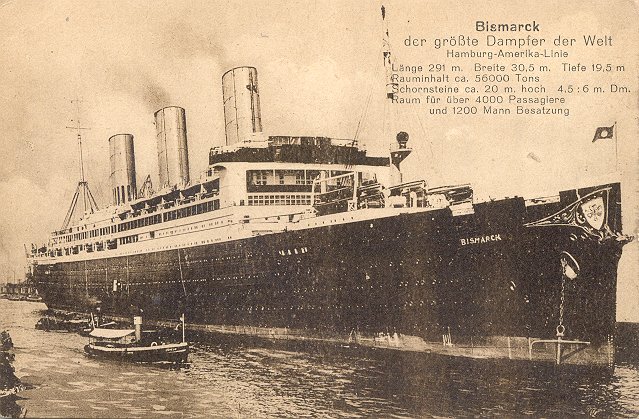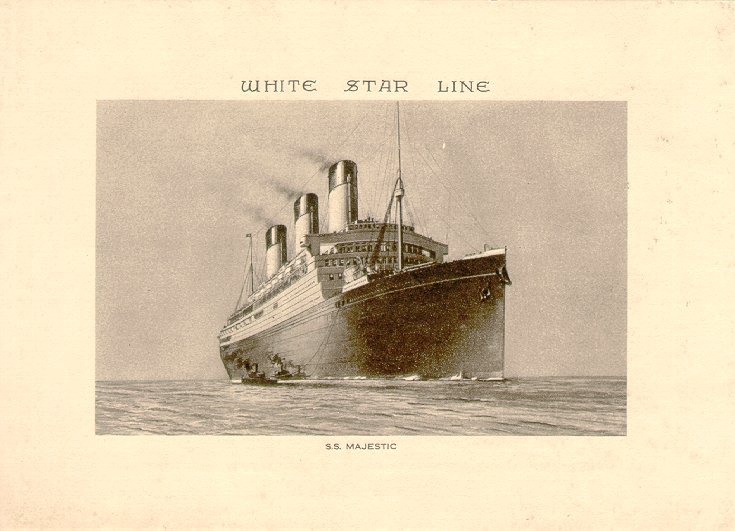In the early 1910's, Albert Ballin of Germany's Hamburg America Line
(Hapag), conceived a trio of great liners to rival Cunard's Lusitania,
Mauretania and Aquitania and White Star's Olympic, Titanic and Gigantic
(later renamed Britannic). The third of these, Bismarck, was laid down
with the Kaiser in attendance at the Blohm & Voss shipyard in Hamburg
in 1913, and launched by Otto von Bismarck's granddaughter, Countess
Hanna von Bismarck, in 1914.
Bismarck lay uncompleted at Hamburg throughout World War I and was
ceded to Great Britain as a war reparation in 1919. Her older sisters,
Imperator and Vaterland, suffered the same fate. Imperator, like
Bismarck, was allocated to Great Britain, and the two ships were
purchased jointly by White Star and Cunard, with Imperator becoming
Cunard's Berengaria, and Bismarck becoming White Star's Majestic. (This
joint ownership was terminated in 1932, at Cunard's request.) Vaterland
was allocated to the United States and became United States Lines'
Leviathan.
After a suspicious fire in October 1920, Harland and Wolff supervised
the balance of Bismarck's fitting out, and she was finally completed in
March 1922.
Although her new owner (White Star) and new name (Majestic) were already
known, she was completed in Hapag's colors and with the name Bismarck on
her bow and stern. After her sea trials, she was formally turned over
to White Star and, while still at Hamburg, was repainted and renamed.
Her maiden voyage from Southampton to New York, took place on 10 May
1922, under the command of newly-appointed White Star Commodore Sir
Bertram Hayes. At 56,551 tons, Majestic was the largest ship in the
world, and would retain that distinction until Normandie's arrival in
1935. (In fact, until 1929 there was no drydock in Britain large enough
to accommodate her, so her annual repairs and a major 1928 refitting had
to be done in Boston.)
In 1924, a 100 foot (30.5 m) crack was discovered in her hull, taking
her out of service for repairs for four months. (Leviathan would develop
a similar crack in 1929.) Otherwise, Majestic served without major
incident on the Southampton-New York service during her White Star
career, with occasional summer cruises out of New York.
In 1934, she, like Berengaria, became part of Cunard White Star.
Majestic made her last transatlantic crossing in February 1936, and was
then sold twice in 1936: first, by White Star to the ship breaking firm
Ward and then by Ward to the Admiralty for use as a cadet training ship
called HMS Caledonia.
In September 1939, HMS Caledonia burned and sank at her moorings at
Rosyth and was sold back to Ward for scrapping.
Sources: Braynard's Classic Ocean Liners, Vol. 1; Haws' Merchant
Fleets; Hayes' Hull Down; Anderson's White Star; de Kerbrech and
Williams' Cunard White Star Liners of the 1930s; The New York Times,
25 August 1932.







